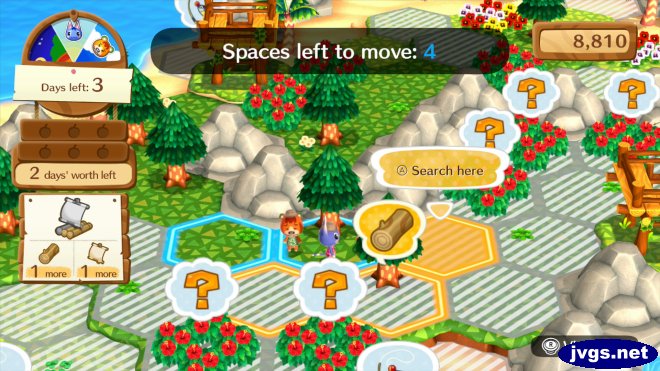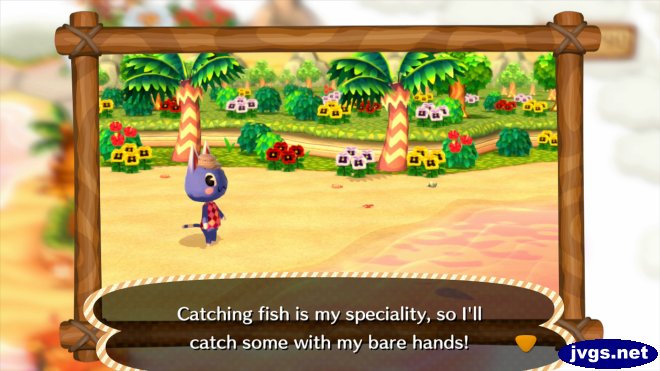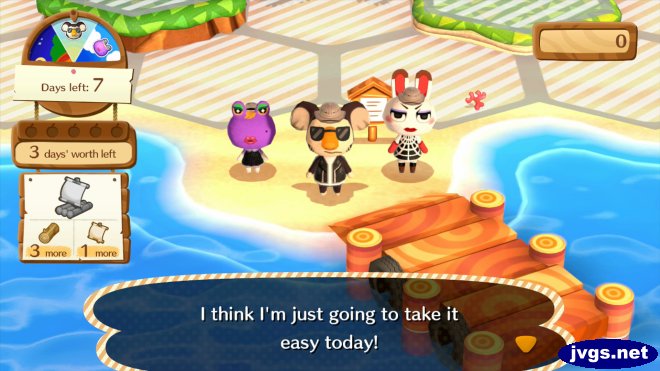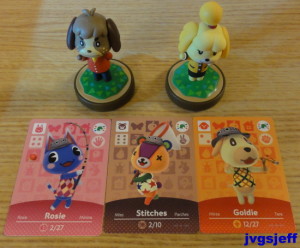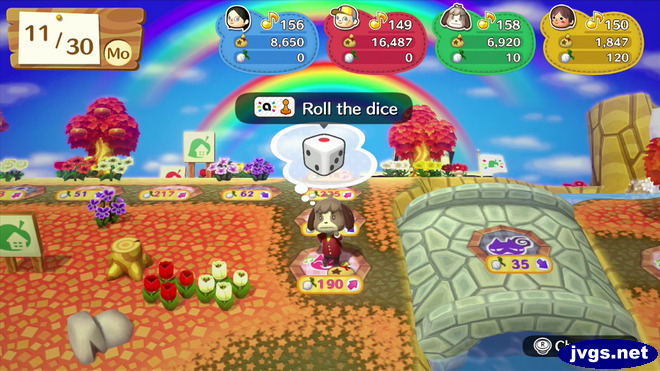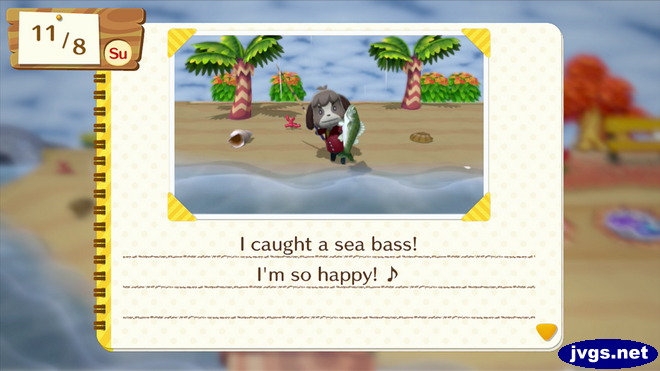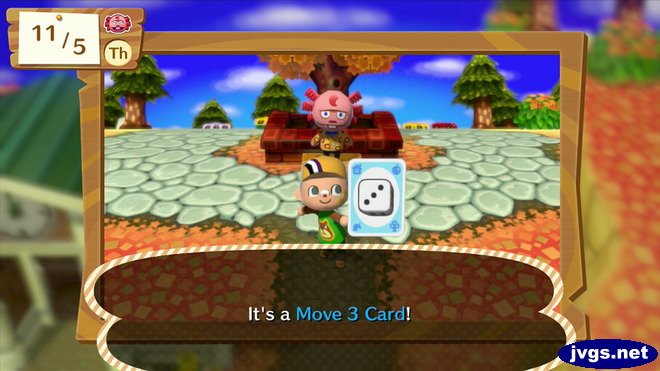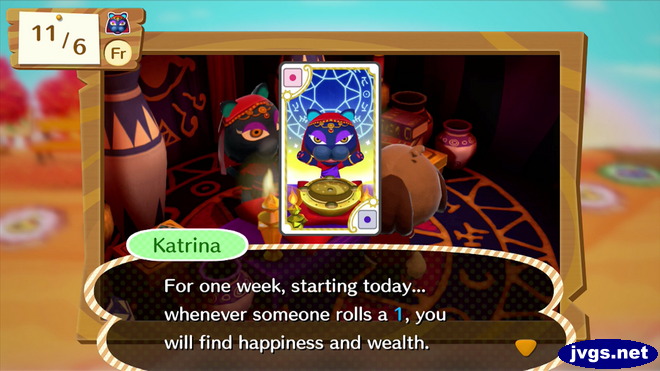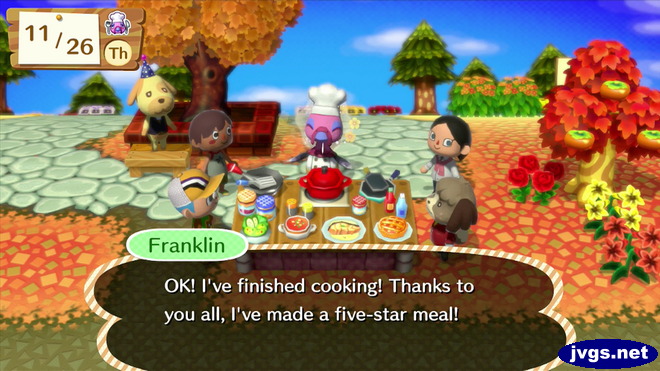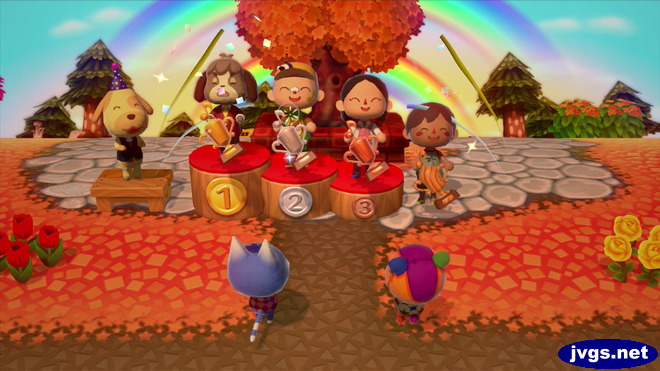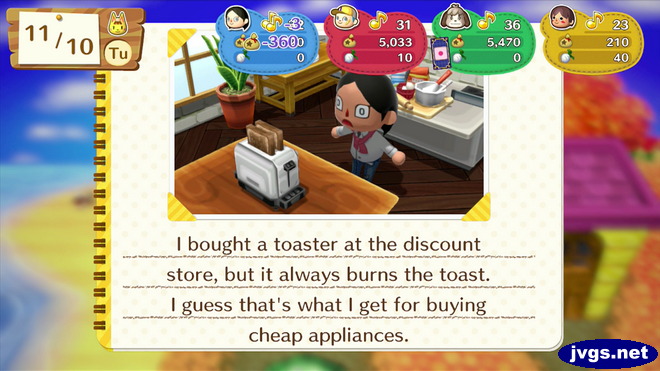Today I’m taking another look at Animal Crossing: Amiibo Festival for Nintendo Wii U. I’ve already posted my impressions of the board game and the enjoyable Desert Island Escape mode (which I’ve recently finished), so now I’m going to discuss some of the other modes in the game.
Quiz Show
This mode is a quiz show where you try to correctly answer as many questions as possible in 90 seconds. Answering questions quickly will also give you a time bonus. The questions test your attention to detail in many aspects of Animal Crossing. You may be asked to identify a specific fish or other item, single out a real painting among several forgeries, or choose the missing item based on a size progression (for example, the third largest type of dragonfly).
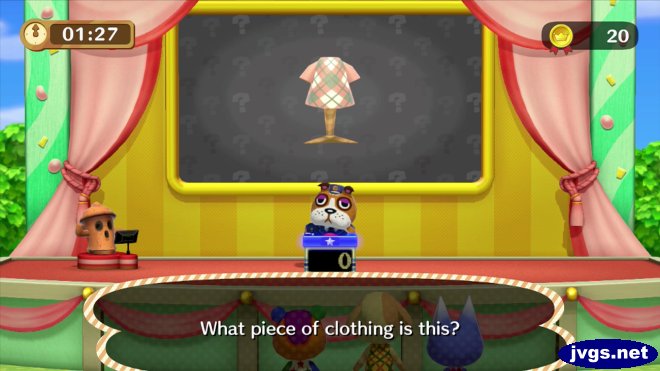 The questions are asked on the TV screen, and the answer choices are displayed on the Wii U gamepad. Why can’t they both be displayed on the same screen? Having to constantly shift your gaze from one display to another seems completely pointless and only slows you down.
The questions are asked on the TV screen, and the answer choices are displayed on the Wii U gamepad. Why can’t they both be displayed on the same screen? Having to constantly shift your gaze from one display to another seems completely pointless and only slows you down.
I actually expected to enjoy this mode a bit, but it was a disappointment. After playing it just a few times, I was ready to move on to something else.
Mystery Campers
This one-player game requires six Amiibo cards. After scanning them all in, four of those six villagers will hide in tents. Your job is to identify which villager is in which tent. Your first choice will be a complete guess, but you are told how many of your guesses are correct and how many are close (but not which ones are which). Using logic, the process of elimination, and a little guesswork, you can ultimately solve the puzzle.
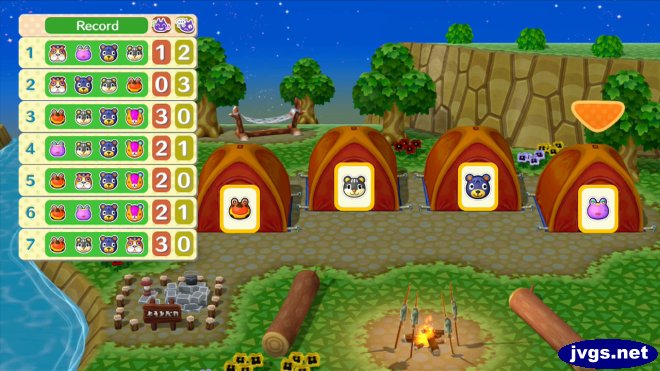 Mystery Campers is a slower paced game that gives you time to think about your next move. While I appreciate the change of pace, it’s still not very enjoyable. And it’s annoying how you must re-scan each card for every guess that you make! You can’t just click the images of the cards that are already displayed on the gamepad.
Mystery Campers is a slower paced game that gives you time to think about your next move. While I appreciate the change of pace, it’s still not very enjoyable. And it’s annoying how you must re-scan each card for every guess that you make! You can’t just click the images of the cards that are already displayed on the gamepad.
Acorn Chase
In this one-player mode, you move three characters across a grid to collect the acorns and head for the exit. Three Amiibo cards are required, and you’ll be using them often…extremely often. In fact, for every single space that you move, you’ll need to scan a card. Each card will represent a direction. For example, you may need to scan Booker to move up, Drift to move right, or Rosie to move down. Those directions are not set in stone and they change each turn. So you will constantly be juggling your three cards around.
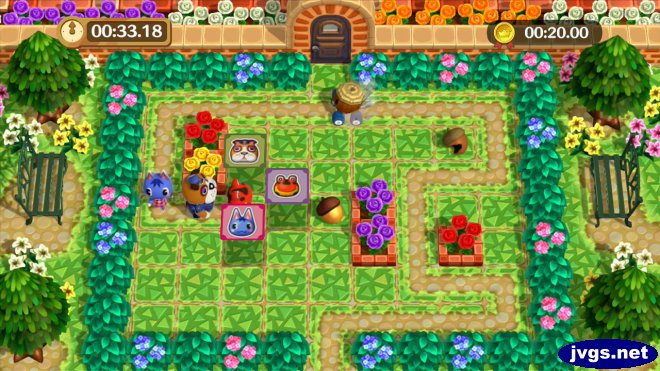 That may sound easy enough, but there are obstacles in your way. There are rotten acorns you’ll need to avoid, and there’s a time limit to keep you moving quickly. Also, a Cornimer car (from the hammer tours in New Leaf) will chase after you. If it catches you, it’s game over. After playing this mode twice, I have no interest in playing it again.
That may sound easy enough, but there are obstacles in your way. There are rotten acorns you’ll need to avoid, and there’s a time limit to keep you moving quickly. Also, a Cornimer car (from the hammer tours in New Leaf) will chase after you. If it catches you, it’s game over. After playing this mode twice, I have no interest in playing it again.
Customizing the Board Game
Even though this isn’t a gameplay mode, it is a cool feature that I haven’t discussed before. You can use an Amiibo card to add a villager to the board game. You can choose from the locations marked with a red signboard, and the villager’s house will appear and he/she will now live in that spot on the board. It may not be a super useful thing, but it is a nice addition to be able to have your favorites nearby each time you endure play the board game.
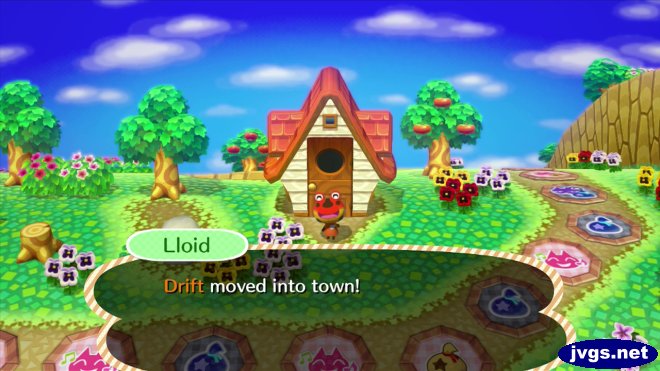 But adding villagers isn’t the only way to customize the board. You can also add features, which generally consist of one or more PWPs (public works projects). You can add them where you see green signboards. I added the “illuminations” feature, which consists of an illuminated arch, illuminated heart, and two illuminated trees.
But adding villagers isn’t the only way to customize the board. You can also add features, which generally consist of one or more PWPs (public works projects). You can add them where you see green signboards. I added the “illuminations” feature, which consists of an illuminated arch, illuminated heart, and two illuminated trees.
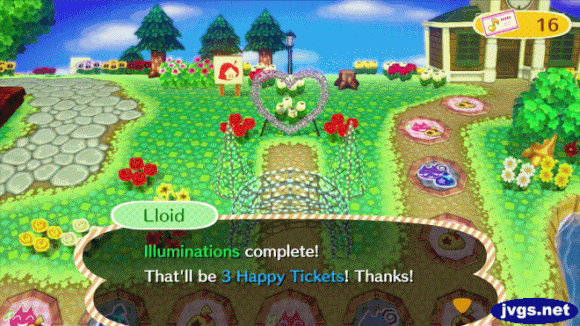 Each one will cost you some Happy Tickets (usually three of them). In addition to the illuminations, I also added a pool, a lighthouse, and a wheat field to my board.
Each one will cost you some Happy Tickets (usually three of them). In addition to the illuminations, I also added a pool, a lighthouse, and a wheat field to my board.
Resetti Bop
This mode resembles the Whack-a-Mole games you may see at arcades. In those games, you use a toy hammer to hit a mole each time it pops up. But in Amiibo Festival, that mole is Resetti and you swing the hammers by scanning Amiibo cards. Much like in Acorn Chase, you will be scrambling to quickly scan the correct card at the correct instant.
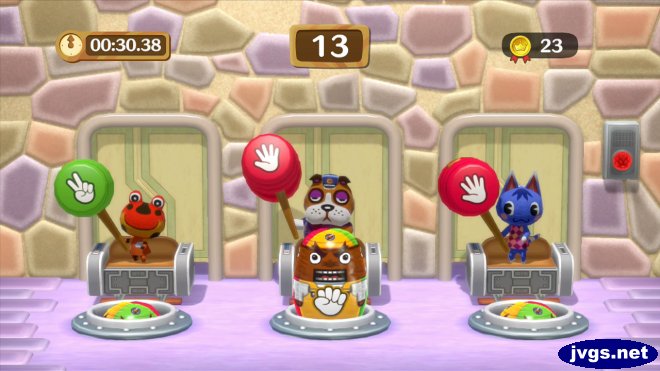 Also, you need to pay attention to the rock-paper-scissors icons. If you smack the wrong one, you’ll actually lose points. Not to mention, scanning the cards is a tricky thing to begin with: They don’t always scan quickly if they’re not in just the right spot on the gamepad. A fast-paced game like this really needs button controls. This is just one of many poor design choices Nintendo made in Amiibo Festival.
Also, you need to pay attention to the rock-paper-scissors icons. If you smack the wrong one, you’ll actually lose points. Not to mention, scanning the cards is a tricky thing to begin with: They don’t always scan quickly if they’re not in just the right spot on the gamepad. A fast-paced game like this really needs button controls. This is just one of many poor design choices Nintendo made in Amiibo Festival.
Balloon Island
In this game, you drop a villager into a field of balloons above a floating island. Each balloon your character pops on the way down will score you points, and he/she will bounce off of the balloons repeatedly. The object is to score as many points as possible and then land safely on the island, which floats from side to side beneath you.
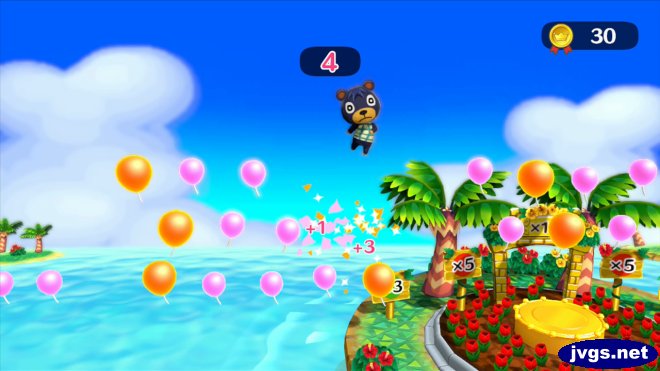 The games are quick and easy, but the main problem is that it’s not really interactive. Sure, you can choose when to drop the villager, but that’s it. It’s all about finding the best time to drop the animal. Like most of the modes, this is not very fun to play.
The games are quick and easy, but the main problem is that it’s not really interactive. Sure, you can choose when to drop the villager, but that’s it. It’s all about finding the best time to drop the animal. Like most of the modes, this is not very fun to play.
Everything Else
There are two other mini-games, Fruit Path and Amiibo Card Battle, that do not have single-player modes. I have not played these games yet, although I will be sure to at least try them before writing my eventual review of Amiibo Festival. But based on the rest of the game, I’m not getting my hopes up.
Check the latest prices for Amiibo Festival or buy some Amiibo cards.
